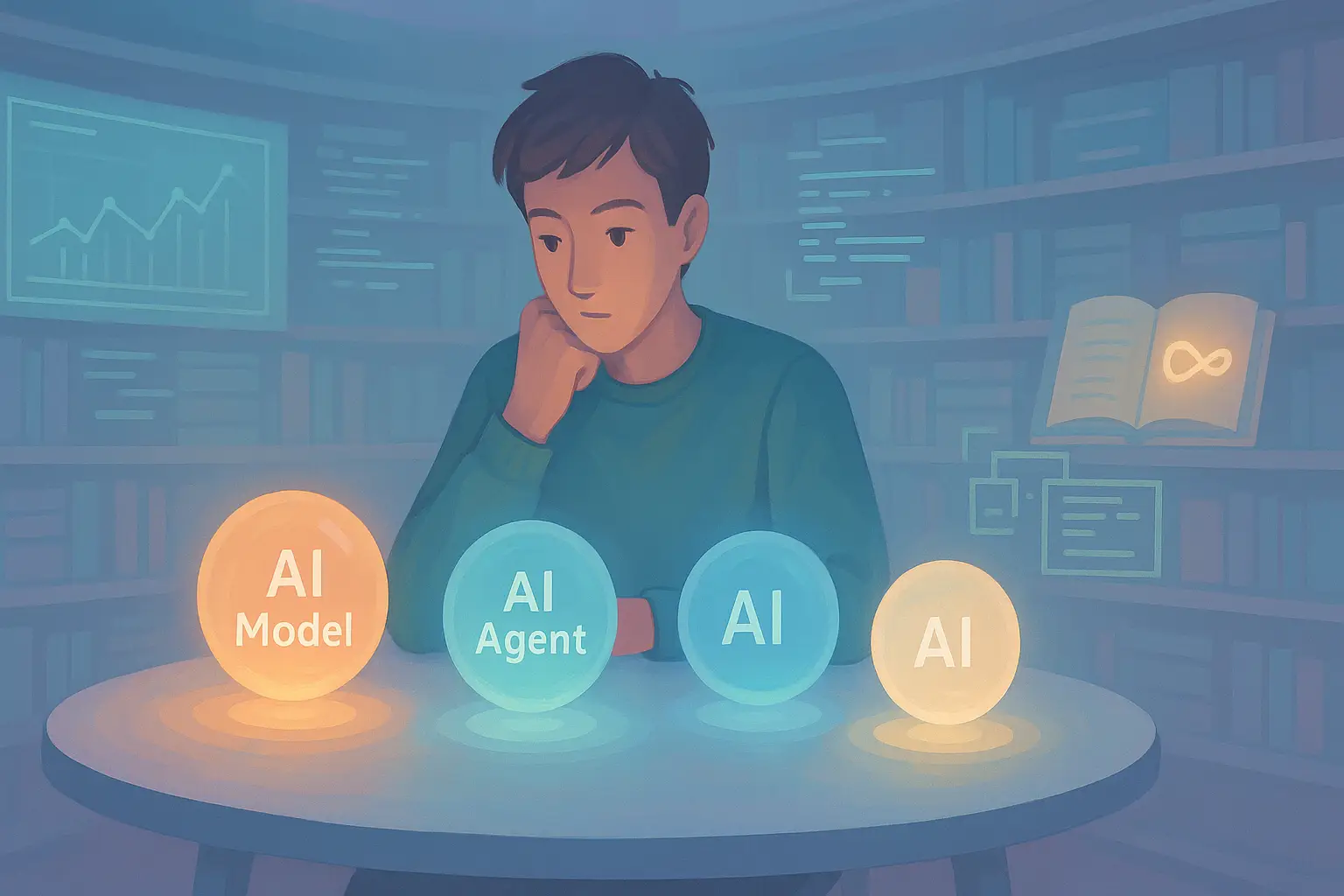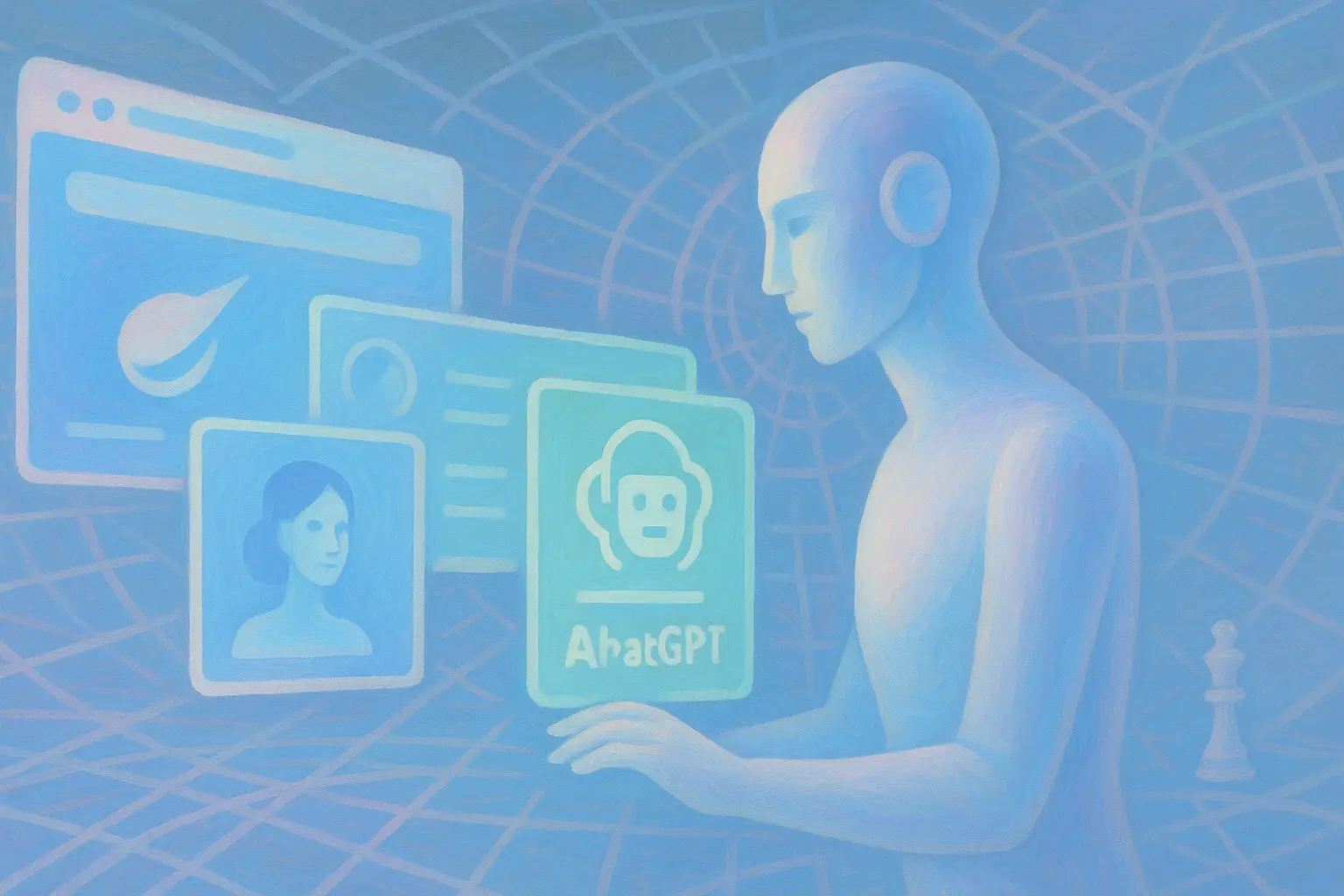
AI Models vs Agents: Complete Guide
Table of Contents
- Introduction
- Understanding AI Models
- Diving into AI Agents
- Unpacking Agentic AI
- Comparing the Concepts
- Applications and Real-World Use Cases
- Ethical and Practical Considerations
- Related Concepts & Future Directions
- Conclusion
- Frequently Asked Questions (FAQs)
Introduction
Artificial Intelligence (AI) has evolved rapidly over the last decade. Today, its terminology can be confusing—even for those who follow the tech trends closely. When I started exploring AI, I too was baffled by the distinctions between an AI model, an AI agent, and Agentic AI. These terms often overlap, yet they refer to different layers within the AI ecosystem.
This article explores these concepts in detail. I have structured it in a way that explains each term using clear language, tables, lists, and helpful examples. Whether you are a beginner or someone with a technical background, this guide is designed to help you navigate through the maze of AI-related terminologies without feeling overwhelmed.
In the ensuing sections, we will systematically break down:
- What an AI model is,
- How AI agents expand on models to act in real-world scenarios,
- What Agentic AI represents in the evolution of autonomous systems,
- The key differences and intersections between these definitions,
- And how other related terms tie into this mix.
By the end, you will have a clear understanding of each component and appreciate how they jointly contribute to shaping tomorrow's intelligent systems.
Generate Veo 3 JSON, Fast
Create structured, optimized JSON for Veo 3 in minutes. Clear fields. Correct syntax. Consistent results.
Open Veo 3 JSON GeneratorUnderstanding AI Models
What is an AI Model?
At its core, an AI model is a specialized algorithm. It is a mathematical structure designed to perform specific tasks such as recognizing patterns, predicting outcomes, or even classifying information based on the data it has been fed. Think of an AI model like a recipe. Just as a recipe contains a set of instructions to create a dish, an AI model contains rules to draw conclusions from data.
AI models become the workhorses behind many smart systems we rely on today. Whether it is identifying spam emails, diagnosing diseases from medical images, or predicting customer behavior, these models drive a wide array of applications.
Types of AI Models
AI models come in different types, each with its unique strengths:
-
Supervised Learning Models:
- Definition: Learn from predefined examples or labeled data.
- Common Applications:
- Classification: Sorting emails into spam or non-spam.
- Regression: Predicting house prices based on historical data.
- Example: A neural network trained on images to recognize handwritten digits.
-
Unsupervised Learning Models:
- Definition: Identify patterns in data without explicit instructions.
- Common Applications:
- Clustering: Grouping similar items without predefined categories.
- Anomaly Detection: Identifying data points that deviate significantly from the norm.
- Example: A model that clusters customer data for targeted marketing efforts.
-
Reinforcement Learning Models:
- Definition: Learn by trial and error, receiving rewards or penalties.
- Common Applications:
- Game Playing: Learning strategies in chess or Go.
- Robotics: Teaching a robot to navigate obstacles.
- Example: An AI model that optimizes game moves in strategic video games.
Common AI Model Architectures
- Neural Networks: Often compared to the human brain, these layers of interconnected nodes can learn complex patterns.
- Decision Trees: Simple yet powerful structures that mimic human decision-making.
- Support Vector Machines (SVMs): Particularly useful when dealing with high-dimensional data.
- Ensemble Methods: Combine multiple models to improve overall performance.
Real-World Examples
- A neural network used in self-driving cars helps to identify pedestrians and obstacles.
- A decision tree might power fraud detection by analyzing financial transactions.
- SVMs are often utilized in text classification tasks, such as filtering customer reviews.
For additional reading, you might check out Younet AI's article on the differences between AI models and agents.
Diving into AI Agents
While AI models focus on processing and reasoning with data, an AI agent takes these capabilities a step further. It is not just about prediction or classification; it is about taking action in the real world.
What is an AI Agent?
An AI agent is a system that uses one or more AI models to interact intelligently with its environment. It can sense, process, decide, and act. This level of integration allows AI agents to operate autonomously. Picture an AI agent as a robot in a factory: it not only calculates what needs to be done using its core computation (its AI models) but then goes out and performs tasks, such as assembling parts or moving objects.
Key Characteristics of AI Agents
AI agents are built on three fundamental constructs:
-
Perception:
- They absorb information from their surroundings.
- This can be through cameras, sensors, microphones, or data feeds.
- For example, a self-driving car uses cameras and LIDAR sensors to map out its surroundings.
-
Decision-Making:
- Once the data is collected, AI agents process it and decide what needs to be done.
- This could involve simple rule-based decisions or complex pattern recognition that requires multiple AI models working together.
-
Action:
- AI agents carry out operations in the physical or digital world.
- These actions might include moving a robotic arm, sending a notification, or executing a trade in a high-frequency trading system.
Types of AI Agents
Depending on the complexity needed, AI agents can range from simple to highly sophisticated. Here are a few types:
-
Simple Reflex Agents:
Operate on a straightforward stimulus-response basis.
Example: A thermostat adjusting room temperature. -
Model-based Reflex Agents:
Retain a memory of past events to make more informed decisions.
Example: A cleaning robot that maps a room to avoid obstacles. -
Goal-based Agents:
Target specific objectives, planning several steps ahead to achieve their goals.
Example: A navigation system that chooses the fastest route to reach a destination. -
Utility-based Agents:
They balance multiple factors to optimize their outcomes.
Example: An e-commerce recommendation system that adapts suggestions based on user behavior. -
Learning Agents:
These agents continuously learn and improve based on feedback from their actions.
Example: Chatbots that refine responses over time based on user interactions.
For a more formal definition, you might refer to the Wikipedia page on Intelligent Agents.
Real-World Examples
- Virtual Assistants: Assistants like Siri, Alexa, and Google Assistant listen to your commands, process them using a blend of AI models, and then act by providing information or executing tasks.
- Autonomous Vehicles: Self-driving cars don’t just observe their environment; they decide on maneuvers like when to brake or accelerate, adapting to conditions in real time.
- Game AI: Agents like those in chess or Go programs use a combination of decision-making models to outperform human players.
Unpacking Agentic AI
Agentic AI takes the concept of an AI agent and raises the bar in terms of autonomy and self-direction. The term is relatively new and does not have a universally accepted definition, yet it is increasingly used to describe systems that operate with minimal—or even no—human intervention.
What is Agentic AI?
Agentic AI refers to advanced AI systems that integrate multiple agents and models to operate in complex, changing environments. They are conceived to be highly autonomous, setting their own goals and adapting strategies accordingly. Think of them as the next generation of AI agents, capable of managing intricate sequences of tasks independently.
Key Traits of Agentic AI
Agentic AI can be broken down into a few distinctive traits:
-
High Autonomy:
- They operate with little to no external oversight.
- This autonomy is enabled by robust self-monitoring and decision-making frameworks.
-
Goal-Oriented Planning:
- Agentic AI systems are not just reactive. They set their own objectives and devise step-by-step plans to achieve long-term missions.
- For example, an agentic system in automated trading might continuously refine its strategy based on market dynamics.
-
Adaptive Learning:
- They are built to learn from every interaction, improving performance and adapting to new external conditions.
- This makes them particularly effective in dynamic environments like traffic management or supply chain logistics.
-
Integration of Multiple Agents:
- Agentic AI often comprises several AI agents working in synergy.
- The resulting system can coordinate a large number of tasks concurrently, much like an orchestra where every instrument plays its part to create harmonious results.
Examples in Practice
- Self-Driving Cars: Advanced systems, such as Tesla’s Full Self-Driving, combine multiple agents—vision systems, path planning, and control mechanisms—to navigate safely even when conditions change rapidly.
- Automated Financial Trading: These systems autonomously process market data, set trading strategies, and execute orders without human interference.
- Smart Manufacturing: In high-tech factories, fleets of robots (each an AI agent) operate together under an overarching system that optimizes production lines and materials handling.
For a thoughtful discussion on this topic, IBM provides insights into Agentic AI.
Comparing the Concepts
Understanding the differences between these terms can be confusing at first. To make it simpler, let’s break it down using a table:
| Term | Definition | Key Components | Real-World Example | Autonomy Level |
|---|---|---|---|---|
| AI Model | The algorithm or mathematical structure trained on data | Data patterns, predictions, classifications | Neural networks, decision trees | None (Core Component) |
| AI Agent | A system that uses AI models to interact with its environment | Perception, decision-making, action | Virtual assistants, autonomous vehicles | Low to Medium |
| Agentic AI | Highly autonomous system using multiple agents for complex tasks | Goal-setting, adaptability, autonomy | Self-driving cars with full autonomy, automated trading systems | High |
Discussion
- An AI model is essentially the puzzle piece that processes information. It does not “do” anything unless it is integrated into a system.
- AI agents are like the workers on the ground. They sense their environment, use models to decide on a course of action, and then execute those actions.
- Agentic AI goes a step further by coordinating among several agents, setting long-term objectives, and managing complex environments with minimal supervision.
In other words, if you consider AI models as ingredients, and AI agents as chefs, Agentic AI is the entire kitchen running independently to create a finely tuned meal.
Applications and Real-World Use Cases
The implications of these technologies extend across several industries. Let’s look at how businesses and researchers are using these systems.
In Healthcare
- AI Models:
- Used for diagnostics by analyzing images, lab reports, and patient histories.
- Applications include predicting disease outbreaks and personalized medicine.
- AI Agents:
- Virtual assistants help patients book appointments or access medical data.
- Agentic AI:
- Multi-agent systems can coordinate treatment plans, monitor patient vitals in real time, and suggest changes in care protocols based on continuous feedback.
Read more about healthcare innovations with AI on Grand View Research.
In Finance
- AI Models:
- Employed to detect fraudulent transactions by learning from past fraudulent behavior.
- AI Agents:
- Chatbots in banking assist with routine inquiries and fund transfers.
- Agentic AI:
- Used to drive high-frequency trading systems. These systems dynamically adjust risk parameters, execute trades based on market trends, and learn from every market interaction.
In Transportation
- AI Models:
- Help in accident prediction by analyzing traffic and weather data.
- AI Agents:
- Present in adaptive cruise control and lane-keeping systems in modern vehicles.
- Agentic AI:
- Facilitates fully autonomous driving systems where the vehicle constantly learns from new road conditions and adjusts routes accordingly.
In Manufacturing
- AI Models:
- Monitor production lines by predicting machine failures before they occur.
- AI Agents:
- Robots on the assembly lines optimize tasks with improved precision and speed.
- Agentic AI:
- Integrates these robots with scheduling systems. This orchestration ensures smooth operations even when disruptions occur unexpectedly.
In Customer Service
- AI Models:
- Analyze interaction data to refine language processing systems.
- AI Agents:
- Chatbots and virtual assistants serve customers 24/7.
- Agentic AI:
- Systems that analyze large volumes of customer data, adapt service approaches in real time, and proactively resolve issues before they escalate.
Ethical and Practical Considerations
As we dive deeper into these advanced AI systems, it's essential not to overlook ethical concerns and practical challenges.
Ethical Implications
-
Bias and Fairness:
- AI models can inadvertently learn biases if they are trained on skewed datasets.
- Ensuring fairness in decision-making, whether in a financial system or healthcare, is crucial.
- It requires constant monitoring and updating of the models and the agents that use them.
-
Transparency and Accountability:
- With AI agents and especially Agentic AI making decisions independently, understanding how decisions are made becomes challenging.
- There is a call for transparency in algorithms and explaining decisions, particularly when they affect human lives.
- Documentation like UC Berkeley's research on Agentic AI offers insight into these concerns.
-
Privacy and Data Security:
- The effectiveness of AI models and agents largely depends on data. Collecting and using this data responsibly is essential.
- Robust frameworks and stringent data security policies can mitigate risks.
Practical Concerns
-
Integration Complexity:
- Bridging the gap between AI models and full-fledged agent systems involves technical challenges.
- Legacy systems in many industries need to be upgraded or rethought entirely.
- The integration efforts necessitate careful planning, testing, and validation.
-
Cost and Scalability:
- The initial setup cost for fully autonomous Agentic AI systems can be steep.
- However, long-term gains in efficiency, reduced errors, and scalability can offset initial investments.
-
Job Displacement:
- Increased automation comes with the risk of reducing certain job categories.
- The shift calls for re-skilling initiatives and planning transitional phases to help affected workers migrate to new roles.
Balancing Innovation and Responsibility
Navigating the future of AI involves balancing the tremendous benefits of automation with the potential downsides. Clear guidelines, ethical standards, and consistent oversight will be the pillars on which successful AI adoption stands.
Related Concepts & Future Directions
Understanding AI models, agents, and agentic AI opens the door to other interconnected ideas in the AI ecosystem.
Auxiliary Concepts
-
Multi-Agent Systems:
Multiple AI agents that interact, collaborate, or sometimes compete to solve complex tasks. They can be found in scenarios ranging from online marketplaces to coordinated rescue missions. -
Cognitive Agents:
Agents that try to mimic human thought processes. While not as autonomous as high-level agentic systems, cognitive agents help in research and development to bridge the gap between mechanical automation and human-like reasoning. -
Autonomous Systems:
Often used interchangeably with Agentic AI, these systems are designed to function without any human interference. They have found applications in autonomous drones, robotic surgery, and even space exploration.
What Does the Future Hold?
The progression from AI models to AI agents and then to Agentic AI signals a promising future where systems become increasingly self-sufficient. Researchers are working towards:
- Enhanced Learning Capabilities:
Integrating real-time data to improve decision-making on the fly. - Better Coordination of Multi-Agent Systems:
Enabling diverse agents to work in sync, much like a team of experts collaborating. - Stronger Ethical Safeguards:
Developing frameworks that ensure these systems operate fairly and transparently.
Industry conferences and publications, such as those found on the IBM Think platform or NVIDIA’s blog on Agentic AI, provide a window into the future research and deployment opportunities in the field.
Conclusion
Navigating the diverse landscape of AI terminology can be challenging. However, by breaking down the roles of AI models, AI agents, and Agentic AI, we can appreciate the layered complexity of these technologies.
- AI models are the basic algorithms, the building blocks that analyze data and produce outputs.
- AI agents take these models and integrate them into systems that interact with the world, making real-time decisions and performing tasks.
- Agentic AI represents the convergence of numerous agents working in unison, capable of setting goals and operating autonomously in dynamic, often unpredictable environments.
As we push further into the realm of autonomous technology, understanding these distinctions will be crucial not just for engineers and researchers, but for all of us trying to make sense of a future shaped by AI. Balancing innovation with ethical responsibility, economic practicality, and practical integration challenges will be key to harnessing AI’s potential for the greater good.
For anyone curious about this dynamic field, staying informed and critically assessing new developments is essential. There is always more to learn, and the story of AI is far from finished.
By exploring the nuances of AI models, AI agents, and Agentic AI, we gain a clearer picture of how these components interact and innovate within the broader AI ecosystem. While AI models are the essential building blocks, AI agents bring that intelligence into the world. Agentic AI, as the next evolution, promises exciting advancements by harmonizing these elements into autonomous systems that can learn, adapt, and operate independently.
Whether you are a tech enthusiast, a professional in the industry, or simply curious about what the future holds, understanding these distinctions is vital. As we advance, we must ensure that the progression towards ever more autonomous systems is tempered with mindfulness regarding ethical and practical challenges. The collaboration between human intuition and AI’s analytical power could potentially reshape our world in unimaginable ways—provided we approach this transformation with careful thought and responsible innovation.
In summary, embracing these evolving AI concepts means welcoming a future where technology works seamlessly alongside us. The continuous dialogue between AI developers, policymakers, and society at large will determine how well we harness these powerful tools for a better, smarter tomorrow.
Frequently Asked Questions
Share this article
Related Articles

ChatGPT Go Free in India: Unlock AI Power 2025!
Explore how OpenAI's ChatGPT Go free offer in India is set to transform AI accessibility, from enhanced features to market impact and strategic benefits.

Atlas vs Comet: AI Browser Battle 2025
Dive deep into the world of AI-native browsers with ChatGPT Atlas and Perplexity Comet. Explore their unique features, philosophies, and the battle that is reshaping how we interact with the web.

ChatGPT Atlas: AI Browser Revolution
Explore how ChatGPT Atlas, OpenAI's groundbreaking AI-powered browser, transforms web browsing with contextual intelligence, personalized automation, and robust privacy controls.
